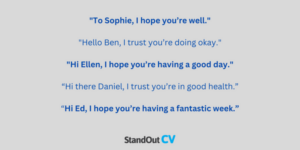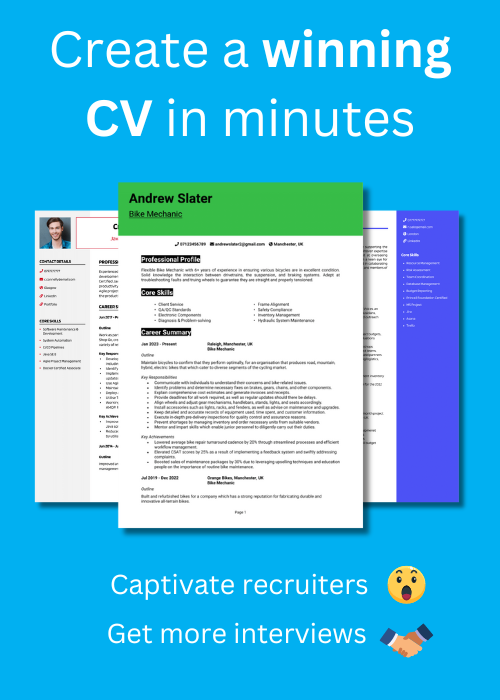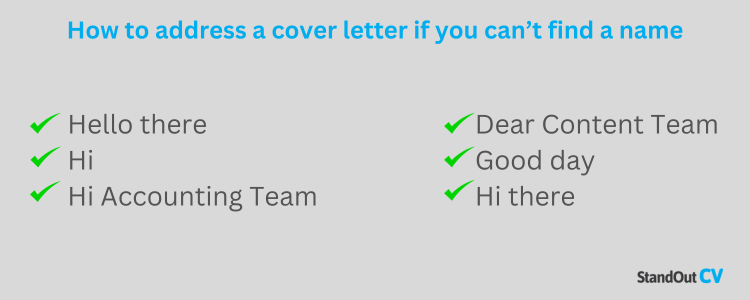
How to address a cover letter | with examples
Try the CV builder

The way you start your cover letter counts.
It’s the first thing a hiring manager sees when they open your application so you need to make them excited to peek into your CV .
In our guide, we’ll show you the ropes on how to address your cover letter, and even teach you how to find the recruiter or hiring manager’s name for maximum impact.
CV templates
Address the hiring manager or recruiter directly

Address the hiring manager or recruiter by name to start building a rapport with them.
Something simple like, “Hi Lucy” will do the trick.
According to recent research , simply seeing your own name can trigger a strong response in the brain. So, be sure to do this, to captivate the recruiter’s attention.

Build your CV now
How to find the recruiter or hiring manager’s name
You may be wondering, “How do I figure out their name?”
There are several ways to find out the name of the person handling the job opening, which we’ll look at below.

When you’re reading a job advert, you’ll sometimes find the name and email address of the person you need to get in touch with directly in the ad.
Look out for the section that says “For enquiries” or “Contact person”.
For example, the advert might say something like:
“For more info, please contact Susan Wright at [email protected].”
Usually, this person manages that job vacancy.
If you see this information, it’s your lucky day – job adverts are the simplest way to find the correct name.
Company website

If you can’t find the recruiter’s name on the job advert , and you’re applying for a job directly via a company, check out their website.
Keep an eye out for a “Who We Are” , “About Us” or “Our Team” section.
Here, you’ll usually be able to find the info about the people who work there, including the head of the department or hiring team connected to the position you’re applying for.
Look at the people’s profiles to get the one that fits your job’s department.
If you have trouble finding it directly, use the search bar on the company’s website and type in “Head of [Department Name]” or “HR Manager”.
You could also run a Google search for “[Company name] + team” for a quick way of finding an About Page for a particular team or department.
LinkedIn is one of the best ways to find a hiring manager or recruiter because millions of them are registered on the platform.
Firstly, ascertain the company that posted the position and the team it’s connected with from the information provided in the job advert.
When you know the department and organisation, head over to LinkedIn . Here, you can use the search bar to look for the company name, department or job title associated with the job opening.
Let’s say you’re applying for a marketing vacancy at Tesco. You can search for “Marketing Manager” in the search bar like this:

Once the search results appear, click the “People” filter button to narrow down your findings further so that you’re only seeing people (and not companies or groups).

Then make sure you choose your target company under “Current Company” – this ensures you only view people who are current employees.
You will need to type the name of the company into the text box like this:

Click on the name of the company you typed in. In this case, it’s “Tesco.”
Then hit the blue “Show results” button.

And examine the profiles that come up.

You’ll be able to find the person handling the job applications by looking for titles such as “recruitment manager” or “team leader” .
And once you view their profiles you may even be able to get hold of their phone number or email address.

Contact info
Here is how you can find a person’s email address via the contact details, if they have entered them.
Click on their profile then seek out the “Contact info” section.
This sits under their profile picture and headline.

If the user has made their contact info visible, you’ll see it here.

About section
Often, you can locate additional contact info, such as email addresses, in the “About” or “Summary” section of their profile.
To do this, scroll down to the user’s “About” section.
If the user has decided to include their email address, you’ll see it here.

If you can’t find an email, you can contact them directly through LinkedIn.
Here’s how you’d do this:
- Send a connection request – Send the person a connection request and a message. When they accept your request, you’ll be able to write an accompanying message.
- Use InMail – If this specific individual isn’t in your network, use the LinkedIn InMail. This is a premium feature which lets you send messages to LinkedIn members outside of your network – it’s useful but do. Of course, there is a fee to use this feature but it’s a useful tool.
What if you can’t find a name?

Don’t panic if you can’t find the name of the individual you’re trying to address. This will happen a lot during your job search .
In such cases, it’s absolutely fine to begin with a friendly “Hi.”
But don’t use expressions like “Dear Sir or Madam” – this sounds extremely outdated and aloof.
If you use the word “Hi”, this ensures your cover letter is more amicable and modern , even when you’re unsure of the person’s name.
This is a courteous and simple way to start if you have difficulty locating the specific hiring manager’s name.
How to write a cover letter email subject line

A recruiter’s inbox gets flooded with applications, so when you write your cover letter email , your initial goal is to entice them to read your email.
You must catch their attention with a compelling subject line and give a captivating reason for them to click on your message.
Avoid using generic subject lines, such as:
- “Check This Out” – Subject lines like this sound spammy, and hiring managers may ignore it.
- “Important” – Recruiters won’t know why your email is important – they might deem it clickbait.
- “CV Attached” – This subject line doesn’t offer any context or engage the recruiter in any way at all.
- “Hire Me” – This comes across as too blunt and provides no context.
- “I Need a Job” – This sounds too direct and may sound a little too desperate.
- “Looking for Work” – While you’re being upfront, this isn’t an engaging subject line.
Instead of including any of these generic subject lines, you must promote your selling points right off the bat.
For instance, use subject lines that highlight your skills and expertise in a concise, screen-friendly title.
Determine your main strengths as an applicant and invent a way to integrate them into your subject line.
You could say something like:
- “Veteran Graphic Designer with a Portfolio of Projects”
- “Registered Nurse with Intensive Care Unit Expertise”
- “Committed Secondary School Teacher with 10 Years’ Classroom Expertise”
- “Certified IT Professional with Experience in Network Security”
These subject lines are effective because they communicate key information and value to hiring managers clearly and concisely. Each tells the recruiter about your qualifications and expertise and is tailored to the specific job or field.
A recruiter is more likely to open an email from someone who can potentially meet their requirements.
A quick tip: Remember, subject lines have a limited amount of space – you’ll probably only be able to squeeze in between 30 and 35 characters.
How not to address a cover letter
When you’re addressing your cover letter , some things simply aren’t worth including. These old-fashioned or overly formal ways of starting a cover letter can make a negative first impression.
So, avoid the below phrases in your cover letter greeting:
- “Dear Sir or Madam” – This is far too old-fashioned and doesn’t show much effort. It’s also fairly impersonal.
- “What’s up, [Department Name]?” – This is excessively informal and will probably give hiring managers the wrong impression about you. It also doesn’t address the specific person.
Steer clear of these unimpressive ways to address your cover letter and plump for a more personal, engaging approach, like “Hi James” or “Hello Sarah”. Don’t forget, you need to get the perfect balance of friendliness and professionalism.

IMAGES
VIDEO
COMMENTS
How to Address an Email Cover Letter. Use these tips for addressing a cover letter email: Subject Line: 5-10 words—"Job Application for" + position you're applying to. Start with a cover letter salutation like Dear Dr. Manzanilla, Put your name, email address, and phone number at the end.
The headline on the image says, "Cover letter format" A woman sits at a table writing on a piece of paper. There's a simple cover letter represented by lines. On one side of the cover letter, there are labels for the sections of the cover letter. The labels are: 1. Date and contact information 2. Salutation/greeting 3. First, introduce yourself 4.
If you're providing a hard copy of your cover letter, handwrite your signature and also include your full typed name. Download Cover Letter Outline Template. To upload the template into Google Docs, go to File > Open > and select the correct downloaded file.
Rule #1: Address your cover letter to the hiring manager using a formal, full-name salutation (if possible). For a cover letter, you should always default to addressing it to the hiring manager for the position you're applying to. Unless you know for sure that the culture of the company is more casual, use the hiring manager's first and ...
For example, 'Dear Austen Myers' is acceptable and considered a professional way to address a cover letter. If you know their gender and wish to use a title in the address, use either 'Ms.' or 'Mr.' to avoid inaccurately describing the recipient's marital status. For example, you'd write 'Dear Ms. Myers' rather than 'Dear ...
What is a good way to address a cover letter? A good way to address a cover letter is by using the hiring manager's full name, preceded by "Dear" and followed by a colon. For example, "Dear Jane Doe:" If the name isn't available, use a title like "Dear Hiring Manager" or "Dear [Job Title] Team.".
The most common and acceptable way to address a cover letter when the letter's recipient is unknown is by using the 'Dear Hiring Manager" greeting. Still, you can use other alternative greetings, including: Dear IT Department. Dear Company ABC Hiring Manager/Recruiter. Dear Head of Nursing. Dear Company XYZ Team.
Here are the most common ways to address a cover letter without a name: To Whom It May Concern. Dear Human Resources Director. Dear Hiring Manager. Dear Recruitment Manager. Additionally, if you want to add a personal touch, address your cover letter to your prospective department or manager.
Click on the name of the company you typed in. In this case, it's "Tesco.". Then hit the blue "Show results" button. And examine the profiles that come up. You'll be able to find the person handling the job applications by looking for titles such as "recruitment manager" or "team leader". And once you view their profiles you ...
Sign-off. Here's a breakdown of how a cover letter should be structured: 1. Add your name and contact information to the header. At the top of your cover letter, include the following information: Name: Your full name should be the focal point of your cover letter's header, so use a large font size and bold text. Phone number.